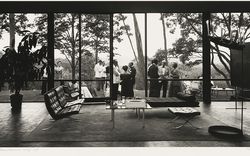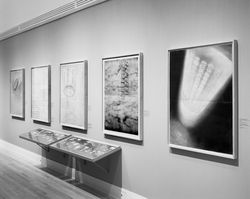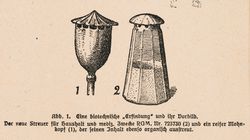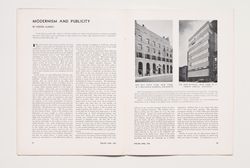articles
Une histoire de références
L’exposition explore certains des moments les plus intenses et les plus marquants de l’histoire de l’architecture : ceux qui ont constitué la période fertile et explosive qui a succédé à la Révolution d’Octobre. Le travail des architectes et graphistes de l’avant-garde était motivé aussi bien par le productivisme que par un souci esthétique. Pour eux, l’architecture et(...)
Salles principales
19 juin 1991 au 8 septembre 1991
Dessins d'architecture de l'avant-garde russe, 1917-1935
Actions:
Description:
L’exposition explore certains des moments les plus intenses et les plus marquants de l’histoire de l’architecture : ceux qui ont constitué la période fertile et explosive qui a succédé à la Révolution d’Octobre. Le travail des architectes et graphistes de l’avant-garde était motivé aussi bien par le productivisme que par un souci esthétique. Pour eux, l’architecture et(...)
Salles principales
1 novembre 2000
documents textuels
AP197.S1.SS3.009
1988
documents textuels
1988
documents textuels
AP197.S2.019
Description:
The box includes writings about Kundera and Tschumi, the poetics of performance, realism and nationalism, medieval Japanese thought, Francesco Rosi, Gustav Mahler, and theatre/cinema. Also included are copies of various publications such as the ARUP Journal (1981), the Granda catalogue (1990), History and Truth by Paul Ricoeur (1965), the Pecularities of English by E.P. Thompson, and German art and German politics by Richard Wagner.
circa 1961- 1990
Various research files about theory, history, art, and the avant-garde
Actions:
AP197.S2.019
Description:
The box includes writings about Kundera and Tschumi, the poetics of performance, realism and nationalism, medieval Japanese thought, Francesco Rosi, Gustav Mahler, and theatre/cinema. Also included are copies of various publications such as the ARUP Journal (1981), the Granda catalogue (1990), History and Truth by Paul Ricoeur (1965), the Pecularities of English by E.P. Thompson, and German art and German politics by Richard Wagner.
documents textuels
circa 1961- 1990
documents textuels
AP197.S1.SS2.127
circa 1967-1970
documents textuels
circa 1967-1970
Sous-série
AP207.S2.SS02
Description:
The sub-series documents the exhibition "Architettura corretta londinese” curated by Pettena and presented at the Palazzo Te in Mantova, in 1981. The exhibition presented the work of young architects from London, including Nigel Coates, Zaha Hadid, Jenny Lowe and Peter Wilson. The exhibition is also the result of Pettena's interest in the critic of contemporary avant-garde architecture. The sub-series contains scans of the exhibition catalogue published by Casa del Mantegna, in Mantova. The sub-series also contains two u-matic tapes of unidentified video recordings possibly related to the exhibition.
1981, 2013 - 2016
Architettura corretta londinese (1981)
Actions:
AP207.S2.SS02
Description:
The sub-series documents the exhibition "Architettura corretta londinese” curated by Pettena and presented at the Palazzo Te in Mantova, in 1981. The exhibition presented the work of young architects from London, including Nigel Coates, Zaha Hadid, Jenny Lowe and Peter Wilson. The exhibition is also the result of Pettena's interest in the critic of contemporary avant-garde architecture. The sub-series contains scans of the exhibition catalogue published by Casa del Mantegna, in Mantova. The sub-series also contains two u-matic tapes of unidentified video recordings possibly related to the exhibition.
Subseries
1981, 2013 - 2016
Projet
Applausi [Applause] (1968)
AP207.S1.1968.PR05
Description:
This project series documents Pettena's design for "Applausi", a suitcase split in half to create two flashing signs with the word "Applausi". The signs were designed for the music performance by Vittorio Gelmetti, "La descrittione del gran paese" a post-pop opera for which Pettena was also in charge of the scene direction. The performance was presented at the 6th Festival of Avant-Garde Music at the Teatro Biondo, in Palermo, in December 1968. The signs were placed on each side of the stage, toward the audience. "The text, together with others that indicated the piano, the singer and the cello, reminded the audience of the habits of an illiterate public participating in a televised show." [1] The "Applausi" signs were also presented in the exhibition "The living currency" in Varsaw, at the Teatr Dramatyczny in 2010, and at the 6th Berlin Biennale at the Hau1, Die lebende Münze, in 2010. The project series contains photographs of the 'Applausi' signs, a drawing of the sign, and a draft poster showing the display of the stage for Vittorio Gelmetti performance at the 6th Festival of Avant-Garde Music. The project series also includes photographs of the music performance, a video of Pettena and the sign at the Berlin Biennale in 2010, and project descriptions in English and Italian. Source: [1] Marco Scotini, editor. Non-conscious architecture: Gianni Pettena, Sternberg Press, 2018, 235 pages. p. 102.
circa 1968-2015
Applausi [Applause] (1968)
Actions:
AP207.S1.1968.PR05
Description:
This project series documents Pettena's design for "Applausi", a suitcase split in half to create two flashing signs with the word "Applausi". The signs were designed for the music performance by Vittorio Gelmetti, "La descrittione del gran paese" a post-pop opera for which Pettena was also in charge of the scene direction. The performance was presented at the 6th Festival of Avant-Garde Music at the Teatro Biondo, in Palermo, in December 1968. The signs were placed on each side of the stage, toward the audience. "The text, together with others that indicated the piano, the singer and the cello, reminded the audience of the habits of an illiterate public participating in a televised show." [1] The "Applausi" signs were also presented in the exhibition "The living currency" in Varsaw, at the Teatr Dramatyczny in 2010, and at the 6th Berlin Biennale at the Hau1, Die lebende Münze, in 2010. The project series contains photographs of the 'Applausi' signs, a drawing of the sign, and a draft poster showing the display of the stage for Vittorio Gelmetti performance at the 6th Festival of Avant-Garde Music. The project series also includes photographs of the music performance, a video of Pettena and the sign at the Berlin Biennale in 2010, and project descriptions in English and Italian. Source: [1] Marco Scotini, editor. Non-conscious architecture: Gianni Pettena, Sternberg Press, 2018, 235 pages. p. 102.
Project
circa 1968-2015
Projet
CI005.S1.1928.PR1
Description:
Oud lectured in 1924-1925 in Prague and Brno on 'The Development of Modern Architecture in the Netherlands' where he made contact with contemporary international architects involved in avant-garde artists circles. As a result of his lecture tours, Oud was commissioned in 1928 to design an apartment building for a private client in Brno, Czechoslovakia. Oud designed a building where each floor consisted of a single dwelling with a communal ground floor that featured shared and functional spaces. The servants' dwelling occupied a separate wing and met with the residential dwellings at the communal staircase and lobby (Taverne et al. 2001, 319). Project series includes drawings of floor plans and elevations.
1928
Three-Family House, Brno, Czechoslovakia (1928)
Actions:
CI005.S1.1928.PR1
Description:
Oud lectured in 1924-1925 in Prague and Brno on 'The Development of Modern Architecture in the Netherlands' where he made contact with contemporary international architects involved in avant-garde artists circles. As a result of his lecture tours, Oud was commissioned in 1928 to design an apartment building for a private client in Brno, Czechoslovakia. Oud designed a building where each floor consisted of a single dwelling with a communal ground floor that featured shared and functional spaces. The servants' dwelling occupied a separate wing and met with the residential dwellings at the communal staircase and lobby (Taverne et al. 2001, 319). Project series includes drawings of floor plans and elevations.
project
1928



